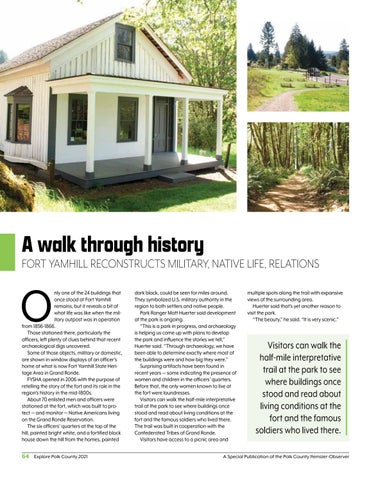A walk through history
FORT YAMHILL RECONSTRUCTS MILITARY, NATIVE LIFE, RELATIONS
O
nly one of the 24 buildings that once stood at Fort Yamhill remains, but it reveals a bit of what life was like when the military outpost was in operation from 1856-1866. Those stationed there, particularly the officers, left plenty of clues behind that recent archaeological digs uncovered. Some of those objects, military or domestic, are shown in window displays of an officer’s home at what is now Fort Yamhill State Heritage Area in Grand Ronde. FYSHA opened in 2006 with the purpose of retelling the story of the fort and its role in the region’s history in the mid-1800s. About 70 enlisted men and officers were stationed at the fort, which was built to protect — and monitor — Native Americans living on the Grand Ronde Reservation. The six officers’ quarters at the top of the hill, painted bright white, and a fortified block house down the hill from the homes, painted
64 Explore Polk County 2021
dark black, could be seen for miles around. They symbolized U.S. military authority in the region to both settlers and native people. Park Ranger Matt Huerter said development at the park is ongoing. “This is a park in progress, and archaeology is helping us come up with plans to develop the park and influence the stories we tell,” Huerter said. “Through archaeology, we have been able to determine exactly where most of the buildings were and how big they were.” Surprising artifacts have been found in recent years — some indicating the presence of women and children in the officers’ quarters. Before that, the only women known to live at the fort were laundresses. Visitors can walk the half-mile interpretative trail at the park to see where buildings once stood and read about living conditions at the fort and the famous soldiers who lived there. The trail was built in cooperation with the Confederated Tribes of Grand Ronde. Visitors have access to a picnic area and
multiple spots along the trail with expansive views of the surrounding area. Huerter said that’s yet another reason to visit the park. “The beauty,” he said. “It is very scenic.”
Visitors can walk the half-mile interpretative trail at the park to see where buildings once stood and read about living conditions at the fort and the famous soldiers who lived there.
A Special Publication of the Polk County Itemizer-Observer
























